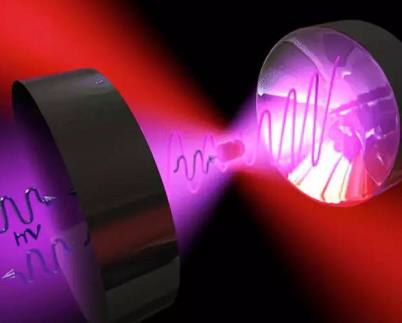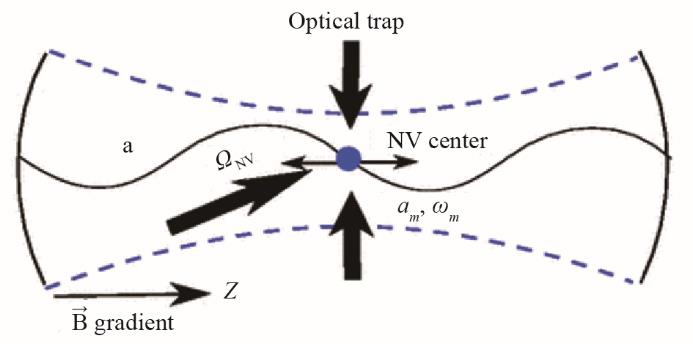《1 Introduction 》
1 Introduction
Optomechanics has been an intriguing topic in the optical and quantum physics fields for decades. We can detect the state of motion of a micro-nanoscale mechanical oscillator by coupling it with a laser beam to achieve a highprecision measurement of small forces, displacement, and mass, which may even break the standard quantum limit. The use of laser beams can also cool a mechanical oscillator down to the quantum state and can achieve quantumsuperposition states, to explore the boundary of classical physics and quantum physics.
The Schrödinger’s cat thought experiment is the most famous macroscopic quantum-superposition-state paradox (Fig. 1). Physicists have been searching for macroscopic objects to prove the paradox of Schrödinger’s cat since he first introduced it in 1935. Although it is impossible to find the quantum-superposition state of life and death, the Schrödinger’s cat state has already been proven for electrons, atoms, and small molecules. It was only recently that scientists proved that the Schrödinger’s cat state exists in macromolecular clusters consisting of hundreds of atoms.
《Fig.1》

Fig. 1. Schrödinger’s cat thought experiment.
The decoherence effect caused by the interaction of a quantum system and its surroundings is the main obstacle to finding the Schrödinger’s cat state. Decoherence rates also increase tremendously with increasing numbers of particles, which will cause a quantum system to collapse to a classical state before it achieves a quantumsuperposition state. To observe the Schrödinger’s cat state in macromolecular clusters, a perfectly isolated system is required to annihilate the coupling between the system and its surroundings and reduce the coupling effect. An isolated system, such as an optomechanical system with nanoscale mechanical oscillators, in a high vacuum and levitated by an optical tweezer, is one such candidate.
In 1970, Arthur Ashkin successfully used a laser to levitate a micron-scale glass sphere in a high vacuum [1]. In 1986, he and Steven Chu invented the optical tweezer, and trapped dielectric particles from 25 nm to 10 μm in a laser beam [2]. Their achievement has been widely used in biology and cold atom physics, and won them the Nobel Prize in physics in 1997 and 2018. In 2009 and 2010, Romero-Isart [3] and D. E. Chang [4], respectively, demonstrated that 100 nm, coupled, dielectric particles, levitated by an optical tweezer in an optical cavity mode, can cool center-of-mass motions to the quantum ground state to achieve quantum-superposition states. More than 108 atoms in one particle made it possible to observe the Schrödinger’s cat state on a macroscopic scale. It is also possible to demonstrate a quantum-superposition state nanoscale virus, as in Fig. 2. In 2010, Tongcang Li [5] used an optical tweezer to trap a microscale glass sphere and detected its instantaneous velocity of Brownian motion to verify the Maxwell velocity distribution. In 2011, active feedback was used to control and cool the center-of-mass motion to milli-Kelvin temperatures [6]; this work commenced the research on levitated optomechanics.
《Fig.2》

Fig. 2. Optically levitated quantum-superposition state of a virus.
《2 Verification of basic physics theory》
2 Verification of basic physics theory
Levitated optomechanics is aimed at basic physics theories at their very foundation, such as how to achieve quantum-superposition states of massive objects as well as matter-wave interference to interpret the boundary of classical physics and quantum physics. The primary condition required to produce a quantum-superposition state is to cool the thermal motion of the system to the quantum regime. First, we need a feedback system to cool thermal phonons to 10 K (in theory). Subsequently, a cavity side-band cooling system is required to achieve the ground state. The first step has already been achieved. Lukas Novotny has cooled a 50 nm optically levitated nanoscale particle down to 100 μK temperatures [7], in accordance with 10 phonons. It is expected that side-band cooling to ground states can be achieved in a few years.
Meanwhile, scientists are exploring more effective ways to generate macroscopic quantum-superposition states in theory. In 2011, Romero-Isart described a matter-wave two-slit interference experiment based on a coupling cavity and nanoscale particles [8]. In 2013, Zhangqi Yin and others [9] proposed binding a nanodiamond to its internal nitrogen-vacancy (NV) center electron spin by coupling light with a gradient magnetic field, as shown in Fig. 3. In the same year, the Bose group of University College London further proposed Ramsey interference of matter waves in the same system, which can eliminate the influence of the thermal motion of particles on the interference.
《Fig.3》

Fig. 3. Achieving Schrödinger’s cat state of the position of the center-of-mass.
Note: a is the cavity mode, am is the nanodiamond center-of-mass motion mode, ωm is the center-of-mass motion frequency, and ΩNV is the Rabi-frequency of the driving wave field.
Recently, several groups have started research on optically levitated NV-nanodiamonds based on those schemes. The nanodiamond has been successfully levitated in a high vacuum, and its nitrogen-vacancy center electron-spin resonance has been demonstrated [11]. Other groups levitated nanocrystals doped with rare-earth elements to cool the internal temperature of the nanocrystal to below 100 K with a coupling laser and phonons [12].
To achieve a higher-stability quantum-superposition-state system and a prolonged matter-wave interference experiment, fifty scientists in Europe proposed the MAQRO [13]. They suggested that the spacecraft expected to be launched by the European Space Agency in 2025 could reach a Lagrangian point (a Sun-Earth gravitational equilibrium point) and engage in matter-wave interference experiments by optically levitated nanoscale particles. Hopefully, these experiments could confirm quantum-gravity effects such as a gravity-induced wave function collapse. As in Fig. 4, gravitational equilibrium and high vacuum can provide the perfect experimental environment for matter-wave interference experiments.
《Fig.4》

Fig. 4. Satellite launched to the L1 Sun-Earth Lagrangian point to conduct matter-wave interference experiments.
Ever since the optically levitated nanometer particle successfully revealed its instantaneous velocity of Brownian motion and verified the Maxwell velocity distribution, levitated optomechanical systems have been widely used to verify thermodynamics and statistical physics, particularly non-equilibrium statistical-physics theory. Nanoscale optical levitation can be used to measure the temperature in nanoscale areas [14]. Recently, researchers from Purdue University and Peking University worked together using this concept to prove the differential-fluctuation theorem of non-equilibrium statistical physics and extend the Jarzynski equality [15]. They also performed the Feynman ratchet experiment [16].
《3 Step into quantum precision measurement》
3 Step into quantum precision measurement
An optically levitated nanoscale particle can reach ultra-high precision in sensing and measurement. American researchers have achieved the measurement of a zeptonewton force with nanospheres at room temperature [17], which may allow us to pursue the precision measurement of molecular mass and the small variation of force, such as Casmir force and Casmir torque [18]. An optically levitated system has reached 10−9 g [19] acceleration sensitivity and long-term work for over a month. Breakthroughs have also been made in some key practical technologies [20–23], which have important application value in long-term self-contained -navigation technologies.
Unlike ordinary optomechanics systems, the trapping frequency of the optically levitated system can be fully tunable; therefore, it is capable of extracting motion information for multiple degrees of freedom simultaneously. Purdue University and Tsinghua University worked together to observe torsional optomechanics of a levitated non-spherical nanoparticle for the first time [24]. Such a system may reach 10−29 N⸱m torsional sensitivity at room temperature to measure the torque produced by the spin of a single electron, or even a single nucleus in a magnetic field (e.g., 0.1 T), directly. In 2018, several research institutes employed this type of system to realize a 1 GHz mechanical rotor [25], which is the fastest solid-state rotor at present. It could be used to create a new type of quantum gyroscope.
With the development of experimental technology, researchers are approaching the realization of quantum ground-state cooling and the preparation of quantum-superposition states using levitated optomechanical systems. Therefore, this precise measurement technology, based on the quantum effect, is expected to be combined with the levitated optomechanical system to develop a measurement technology with higher accuracy than cold atom interferometry. For example, using techniques similar to those of an atomic interferometer, matter-wave interferometry is expected to achieve a high-precision gravimeter [26]. Because the wavelength of a material wave of nanoparticles is much shorter than that of a cold atom interferometer, the phase shift caused by gravity can be measured more accurately, and a higher accuracy gravimeter can be realized.
《4 Disruptive technologies for inertial navigation and sensing detection》
4 Disruptive technologies for inertial navigation and sensing detection
After hundreds of years of development of inertial sensing technology, electromechanical instruments and optical instruments are the mainstream products at present. In recent years, progress in the theory and practice of quantum technology has provided new space for information science. It promises broad application prospects in the field of inertial sensing technology, and has become the frontier technology of the world’s power countries competing for development. At some point, a third type of inertial sensing technology (quantum instruments) will be developed.
Quantum instruments have high theoretical precision. Most research is based on two principles: cold atom interferometry, as in the cold atomic gravimeter, cold atomic gyroscope, and cold atomic accelerometer, and the hot atom spin principle, as in the magnetic resonance gyroscope and the spin-exchange relaxation free gyroscope.
Having rapidly developed in recent years, levitated optomechanics combines optomechanics and quantum optics, provides a new quantum method for controlling and measuring micro-nanoscale mechanical oscillators, and is now a platform for the exploration of quantum manipulation. This method has unprecedented observation accuracy, can approach or even break through the standard quantum limit, and has broad prospects in development and application. It is possible to develop quantum inertial sensing instruments outside the realm of the cold atom interferometry principle and the hot atom spin principle.
Quantum inertial sensor technology based on levitated optomechanics has several characteristics, as follows:
(1) Solid-state sensing unit. The sensing unit is a stably levitated micro-nanoscale solid-state medium, which can perform continuous, real-time, and highly dynamic measurements.
(2) Ultra-sensitivity. The mechanical quality factor of the suspended micro-nanoscale solid-state medium can reach more than 1010, and the equivalent thermal temperature of the motion of the center-of-mass can be cooled to less than a milli-Kelvin; therefore, its theoretical sensitivity is much higher than that of the classical solid-state inertial sensor.
(3) High resolution. The resolution limit is set by the momentum recoil of photons. For example, the single photon momentum recoil is 10-17 g while using a 10 micron-diameter levitated quartz sphere for acceleration sensing.
(4) High stability. An optically levitated micro-nanoscale solid-state medium in a vacuum can completely avoid the stress-time effect caused by a mechanical support, which is the key issue with the stability of a solid-state sensor.
(5) Large range. The measurement range of the sensor depends on the closed-loop control ability of the photon momentum. If the accelerometer is sensed by a 10 micron-diameter levitated quartz sphere, the measurement range can reach more than 10 g under the closed-loop control with laser power of 100 mW.
In addition, in a levitated optomechanics system, a micro-nanoscale mechanical oscillator may be transferred into the quantum region, and this may help achieve solid-state matter-wave interferometry and push inertial sensing technology from optical interferometry (optical gyroscope) and atomic interferometry (cold atomic gravimeter, cold atomic gyroscope) to solid-state matter-wave interferometry, bringing a great revolution to the sensing and precision measurement fields.
《5 Conclusion》
5 Conclusion
As a newly developed frontier technology, levitated optomechanics has gradually moved from basic research to application, particularly in the field of inertial sensing and precision measurement. The US and European developed countries have devoted great effort to promoting research in this area. The Fundamental Science on Optical Inertial and Sensing Technology National Defense Key Laboratory of Zhejiang University, a key institution of exploratory and innovative basic research, and a frontier technology-research institution in the field of inertial sensing technology in China, is willing to work with colleagues at home and abroad to seize the opportunity of (and vigorously develop) levitated optomechanics and its applications in the field of inertial sensing. This will promote the intergenerational leap of inertial sensing technology from mechatronics and optics to quantum in China.













 京公网安备 11010502051620号
京公网安备 11010502051620号




